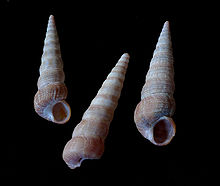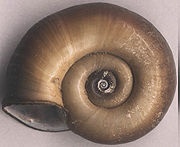
Spire (mollusc)
Encyclopedia


Whorl (mollusc)
A whorl is a single, complete 360° revolution or turn in the spiral growth of a mollusc shell. A spiral configuration of the shell is found in of numerous gastropods, but it is also found in shelled cephalopods including Nautilus, Spirula and the large extinct subclass of cephalopods known as the...
except for the body whorl
Body whorl
Body whorl is part of the morphology of a coiled gastropod mollusk.- In gastropods :In gastropods, the body whorl, or last whorl, is the most recently-formed and largest whorl of a spiral or helical shell, terminating in the aperture...
. Each spire whorl represents a rotation of 360°.
The word "spire" is most often applied to part of the shell of a snail
Snail
Snail is a common name applied to most of the members of the molluscan class Gastropoda that have coiled shells in the adult stage. When the word is used in its most general sense, it includes sea snails, land snails and freshwater snails. The word snail without any qualifier is however more often...
, a gastropod mollusc, a gastropod shell
Gastropod shell
The gastropod shell is a shell which is part of the body of a gastropod or snail, one kind of mollusc. The gastropod shell is an external skeleton or exoskeleton, which serves not only for muscle attachment, but also for protection from predators and from mechanical damage...
, but it has also been applied to the whorls of the shell in ammonite
Ammonite
Ammonite, as a zoological or paleontological term, refers to any member of the Ammonoidea an extinct subclass within the Molluscan class Cephalopoda which are more closely related to living coleoids Ammonite, as a zoological or paleontological term, refers to any member of the Ammonoidea an extinct...
s, which are fossil
Fossil
Fossils are the preserved remains or traces of animals , plants, and other organisms from the remote past...
shelled cephalopod
Cephalopod
A cephalopod is any member of the molluscan class Cephalopoda . These exclusively marine animals are characterized by bilateral body symmetry, a prominent head, and a set of arms or tentacles modified from the primitive molluscan foot...
s.
In textbook illustrations of gastropod shells, the tradition (with a few exceptions) is to show the majority of shells with the spire uppermost on the page.
The spire, when it is not damaged or eroded, includes the protoconch
Protoconch
A protoconch is an embryonic or larval shell of some classes of molluscs, e.g., the initial chamber of an ammonite or the larval shell of a gastropod...
(also called the nuclear whorls or the larval shell), and most of the subsequent teleoconch whorls (also called the postnuclear whorls), which gradually increase in size as they are formed. Thus the spire in most gastropods is pointed, the tip being known as the "apex
Apex (mollusc)
Apex is an anatomical term for the tip of the mollusc shell of a gastropod, scaphopod, or cephalopod mollusc.-Gastropods:The word "apex" is most often used to mean the tip of the spire of the shell of a gastropod...
". The word "spire" is used, in an analogy to a church spire
Spire
A spire is a tapering conical or pyramidal structure on the top of a building, particularly a church tower. Etymologically, the word is derived from the Old English word spir, meaning a sprout, shoot, or stalk of grass....
or rock spire, a high, thin, pinnacle.
The "spire angle" is the angle, as seen from the apex, at which a spire increases in size. It is an angle formed by imaginary lines tangent to the spire.
Some gastropod shells have very high spires (the shell is much higher than wide), some have low spires (the shell is much wider than high), and there are all possible grades between. In a few gastropod families the shells are not helical in their coiling, but instead are planispiral, flat-coiled. In these shells, the spire does not have a raised point, but instead is sunken.
Gastropod shells that are not spirally coiled (for example shells of limpet
Limpet
Limpet is a common name for a number of different kinds of saltwater and freshwater snails ; it is applied to those snails that have a simple shell which is more or less conical in shape, and either is not spirally coiled, or appears not to be coiled in the adult snails.The name limpet is most...
s) have no columella.
Decollated shells
In some species as high-spired shells become adult the soft parts of the animal cease to occupy the upper parts of the cavity of the shell. The space thus vacated is sometimes filled with solid shell, as in MagilusMagilus
Magilus is a genus of sea snails, marine gastropod mollusks in the family Muricidae, the murex snails or rock snails.This genus was brought by Michel into the separate family Magilidae together with Latiaxis-Species:...
; or it is partitioned off, as in Vermetus
Vermetus
Vermetus is a genus of sea snails, marine gastropod mollusks in the family Vermetidae, the worm snails or worm shells.-Species:Species within the genus Vermetus include:* Vermetus afer * Vermetus alii Hadfield & Kay, 1972...
, Euomphalus
Euomphalus
Euomphalus is a genus of fossil marine gastropods known to have lived from the Silurian to the Middle Permian. Euomphalus is characterized by a closely coiled shell with a depressed to slightly elevated spire and a channel-bearing angulation on the upper surface of the whorls...
, Turritella
Turritella
Turritella is a genus of medium-sized sea snails with an operculum, marine gastropod mollusks in the family Turritellidae. They have tightly coiled shells, whose overall shape is basically that of an elongated cone....
, Triton or Caecum. The empty apex
Apex (mollusc)
Apex is an anatomical term for the tip of the mollusc shell of a gastropod, scaphopod, or cephalopod mollusc.-Gastropods:The word "apex" is most often used to mean the tip of the spire of the shell of a gastropod...
in these shells is sometimes very thin, and becomes brittle. In some species it breaks away, leaving the shell truncated or decollated. Decollated shells usually have the whorls
Whorl (mollusc)
A whorl is a single, complete 360° revolution or turn in the spiral growth of a mollusc shell. A spiral configuration of the shell is found in of numerous gastropods, but it is also found in shelled cephalopods including Nautilus, Spirula and the large extinct subclass of cephalopods known as the...
of the spire closely wound and not increasing much in diameter. A typical example is the decollate snail
Decollate snail
The decollate snail, scientific name Rumina decollata, is a medium-sized predatory land snail, a species of terrestrial pulmonate gastropod mollusk in the family Subulinidae.-Distribution:...
(Rumina decollata).
The form of a shell
The form of the shell of a gastropod is usually regular in coiling, and is normally a cone curved into a spiral, and descending in a screw-like manner from the apexApex (mollusc)
Apex is an anatomical term for the tip of the mollusc shell of a gastropod, scaphopod, or cephalopod mollusc.-Gastropods:The word "apex" is most often used to mean the tip of the spire of the shell of a gastropod...
or initial whorl
Whorl (mollusc)
A whorl is a single, complete 360° revolution or turn in the spiral growth of a mollusc shell. A spiral configuration of the shell is found in of numerous gastropods, but it is also found in shelled cephalopods including Nautilus, Spirula and the large extinct subclass of cephalopods known as the...
to the aperture
Aperture (mollusc)
The aperture is an opening in certain kinds of mollusc shells: it is the main opening of the shell, where part of the body of the animal emerges for locomotion, feeding, etc....
. The shell grows in a regular geometrical progression in its normal pattern, although these modes vary among themselves widely. Thus we have the simple depressed cone of Patella, all aperture and no spire. From it there is every gradation, from the Haliotis, almost equally depressed and broad, the result, however, of a very rapidly enlarging spiral, to the long, many-whorled Turritella
Turritella
Turritella is a genus of medium-sized sea snails with an operculum, marine gastropod mollusks in the family Turritellidae. They have tightly coiled shells, whose overall shape is basically that of an elongated cone....
or Vermetus
Vermetus
Vermetus is a genus of sea snails, marine gastropod mollusks in the family Vermetidae, the worm snails or worm shells.-Species:Species within the genus Vermetus include:* Vermetus afer * Vermetus alii Hadfield & Kay, 1972...
, which is a Turitella partially unrolled into a simple long tube — the
opposite of the Patella.
Different types of spire
See also : Gastropod shell#Shape of the shell- Turbinoform or Turbinate: having a broadly conical spire and a convex base, as in Turbo, turban-shaped.
- Turriform: with a many-whorled, slender spire, as in TurritellaTurritellaTurritella is a genus of medium-sized sea snails with an operculum, marine gastropod mollusks in the family Turritellidae. They have tightly coiled shells, whose overall shape is basically that of an elongated cone....
.
Chirality
In most spiral shells the spire normally curves to the right, that is to say, placing the shell with its apexApex (mollusc)
Apex is an anatomical term for the tip of the mollusc shell of a gastropod, scaphopod, or cephalopod mollusc.-Gastropods:The word "apex" is most often used to mean the tip of the spire of the shell of a gastropod...
turned upward from the observer and its aperture
Aperture (mollusc)
The aperture is an opening in certain kinds of mollusc shells: it is the main opening of the shell, where part of the body of the animal emerges for locomotion, feeding, etc....
in view : the aperture will be found on the right hand. In others the volutions proceed in the opposite direction with such regularity as to be eminently characteristic of some species and genera (Physa
Physa
Physa is a genus of small, left-handed or sinistral, air-breathing freshwater snails, aquatic pulmonate gastropod mollusks in the family Physidae.These snails eat algae, diatoms and detritus.- Anatomy :...
, Clausilia
Clausilia
Clausilia is a European genus of small, air-breathing land snails, terrestrial pulmonate gastropod mollusks in the family Clausiliidae, the door snails, all of which have a clausilium....
, etc.). However, in certain genera, it is found that species normally dextral will exceptionally produce sinistrally coiled shells, and vice versa. This abnormal growth probably is caused by disturbance of the relations of the embryo with its initial shell.

